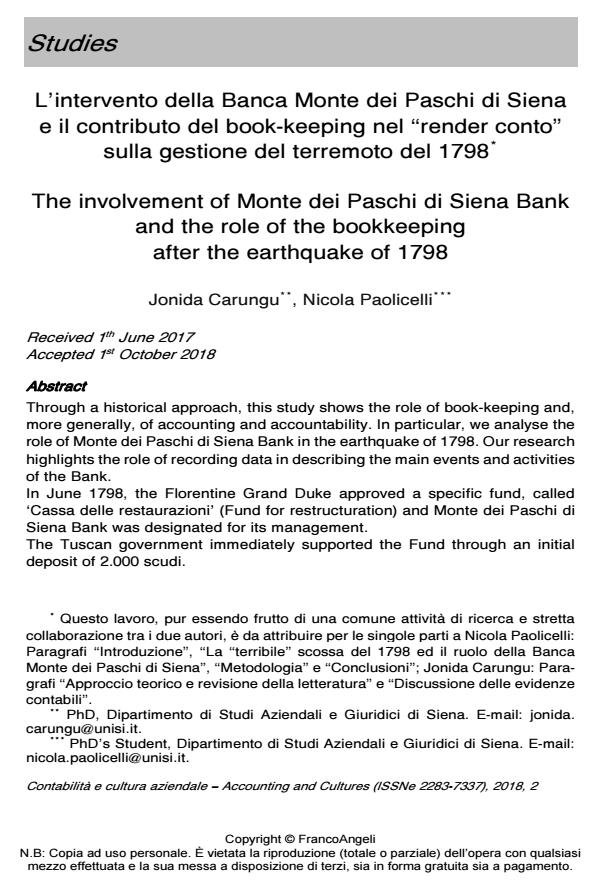The involvement of Monte dei Paschi di Siena Bank and the role of the bookkeeping after the earthquake of 1798
Journal title CONTABILITÀ E CULTURA AZIENDALE
Author/s Jonida Carungu, Nicola Paolicelli
Publishing Year 2019 Issue 2018/2
Language Italian Pages 33 P. 85-117 File size 236 KB
DOI 10.3280/CCA2018-002005
DOI is like a bar code for intellectual property: to have more infomation
click here
Below, you can see the article first page
If you want to buy this article in PDF format, you can do it, following the instructions to buy download credits

FrancoAngeli is member of Publishers International Linking Association, Inc (PILA), a not-for-profit association which run the CrossRef service enabling links to and from online scholarly content.
Through a historical approach, this study shows the role of book-keeping and, more generally, of accounting and accountability. In particular, we analyse the role of Monte dei Paschi di Siena Bank in the earthquake of 1798. Our research highlights the role of recording data in describing the main events and activities of the Bank. In June 1798, the Florentine Grand Duke approved a specific fund, called ‘Cassa delle restaurazioni’ (Fund for restructuration) and Monte dei Paschi di Siena Bank was designated for its management. The Tuscan government immediately supported the Fund through an initial deposit of 2.000 scudi. The local ecclesiastical heritage increased the fund with 3.000 scudi. The initial balance of 5.000 scudi was managed by the bank and they were immediately expended as funds to restore the ruined buildings. Therefore, based on a case study with archival sources, we analyse the administration of the whole fund. In doing so, we try to engage with the sub-research area of accounting for natural disasters. In this sense, our contribution is the exploration of a natural disaster at the end of the XVIII Century. We also contribute to increasing the historical research on the banking sector and the significant role of book-keeping, accounting, and accountability.
Keywords: Accounting for Natural Disasters, Bookkeeping, Monte dei Paschi di Siena Bank, Earthquake, Archival sources, XVIII-XIX Centuries.
Jonida Carungu, Nicola Paolicelli, L’intervento della Banca Monte dei Paschi di Siena e il contributo del book-keeping nel "render conto" sulla gestione del terremoto del 1798 in "CONTABILITÀ E CULTURA AZIENDALE" 2/2018, pp 85-117, DOI: 10.3280/CCA2018-002005